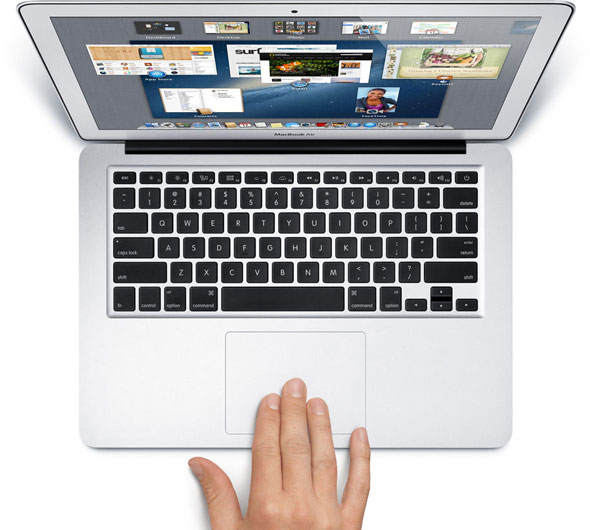Apple's Haswell-Powered 13-Inch MacBook Air
Design & Layout
If you've laid eyes or hands on previous generation Apple MacBook Air machines, the new for 2013 MacBook Air is going to look and feel virtually identical to what you've experienced previously. This of course is likely not a bad thing for most folks, since Apple's mechanical design aesthetics have set the industry watermark for quite some time now. In fact, the Air's thin, all-aluminum exterior has seen the sincerest form of flattery from the competition, over and over again. To be candid, however, it does feel like Apple is due for a design refresh with their MacBook line. Though we can't argue with success, why not take it up a notch again?












One thing the MacBook Air has going for it, that we have rarely seen achieved in competitive Ultrabooks, is the fingerprint resistance of its all aluminum exterior. The surface exterior of the MacBook air does a really good job of keeping it clean and almost smudge-free. As expected, fit and finish is also top notch, with zero flex in the keyboard area and a comfortable, spacious key layout that has solid, tactile response. Apple's glass multi-touch trackpad is also roomy and very responsive, with seemingly instantaneous reaction to pinch and zoom control, as well as multi-touch scrolling and navigation.
If we had to pick a competitive Ultrabook versus the MacBook Air, in this area, we'd say Lenovo's ThinkPad X1 Carbon comes close, though the keyboard of that machine does have some give to it. The Apple typing and control experience is a no-compromise, top-shelf affair. And you guessed it -- a backlit keyboard is standard with this machine, as we feel it should be with all notebooks in this class of device.
If we had to pick a competitive Ultrabook versus the MacBook Air, in this area, we'd say Lenovo's ThinkPad X1 Carbon comes close, though the keyboard of that machine does have some give to it. The Apple typing and control experience is a no-compromise, top-shelf affair. And you guessed it -- a backlit keyboard is standard with this machine, as we feel it should be with all notebooks in this class of device.

Hey, it's not a "retina" display but what's in a name anyway? Though we could always go for a bunch more pixels jammed into its 13-inches, a 1440x900 resolution display is not too shabby either. In addition, keeping resolution down inside a reasonable stratosphere we're sure helps keep cost in check as well. That said, the 13-inch Air's display is bright and vibrant with good color uniformity and off-angle viewing. We do, however, wish there was a tad less glare on the panel. We've been spoiled by some high quality matte finish displays as of late and when the light hits the MacBook Air just right, well, the results are "glaring." No worries, I won't quit my day job for stand-up anytime soon. Regardless, the MacBook Air 13's display is really quite nice, suitable for more strenuous graphics work, pedestrian office requirements or play.


So the MacBook Air 13 is only a little over half an inch thick at the rear of its chassis - its thickest dimension. As a result, you're not going to squeeze a lot of IO options on the edge of this machine. Apple offers a pair of SuperSpeed USB 3.0 ports, and SD card slot, a headphone jack, their fancy-pants MagSafe 2 power port and if you squint, you see it - the one difference between last year's MacBook Air and this year's. Right down there next to the headphone jack are not one but two tiny pinholes for dual omnidirectional mics - eureka! We kid, but that's the only difference in the chassis design, literally. Last but not least is the MacBook Air's high speed Thunderbolt port, which by the way also doubles as a mini-DisplayPort port. Is that too many "ports?" Beside the over-use of the word "port," some may find the MacBook Air comes up a little short, with no Ethernet or mini-HDMI ports available. Apple takes care of the latter IO requirement with a DisplayPort to HMDI adapter that you can buy separately.

With signature-good looks and very high quality materials at play, the MacBook Air 13 really does still set the bar for quality and durability. Again, a little less gloss on the display is all we'd ask for but that's splitting hairs, to be honest.
What really helps the new MacBook Air 13 stand out from last year's model, however, is what's under the hood that you're not seeing here - namely Intel's Haswell CPU architecture with a stronger graphics engine, and that PCI Express SSD we've been rambling-on so emphatically about. The combination of the two should offer a user experience tour de force. We'll see in our forthcoming benchmark numbers if this pans out but for now, let's look at the Air's software package to get a sense of what you can expect out of the box.
What really helps the new MacBook Air 13 stand out from last year's model, however, is what's under the hood that you're not seeing here - namely Intel's Haswell CPU architecture with a stronger graphics engine, and that PCI Express SSD we've been rambling-on so emphatically about. The combination of the two should offer a user experience tour de force. We'll see in our forthcoming benchmark numbers if this pans out but for now, let's look at the Air's software package to get a sense of what you can expect out of the box.






